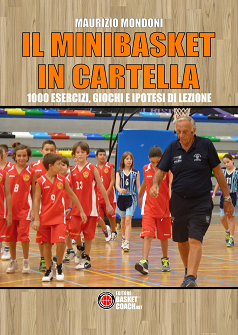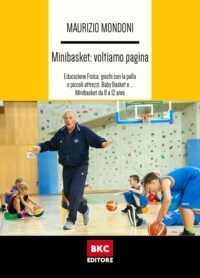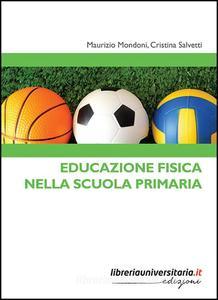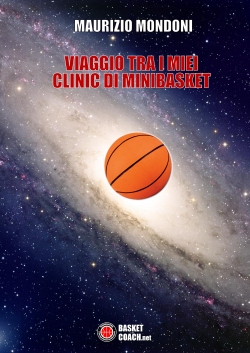40 drills for Defense and combination with dribbling, passing and shooting
DRILLS
When playing, sometimes a team defends and sometimes it is an offensive position. Therefore, if a player has the ball he must try to defend it (understanding the movements of one’s own body, good ball-handling, knowledge of space and time, etc.). If the opponent takes the ball away, then the team must be able to get possession of it again (without making fouls, therefore with good balance and coordination) and must also be able to defend the team’s basket. These concepts are not clear to children in the beginning, so the
Instructor must propose logical game-drills, which are motivating and help children to understand:
• that the ball must be defended (ball protection);
• that if you are guarding against the player with the ball you have to do more than try to take it away;
• that if you are defending the player without the ball, you must stop him from receiving it (children instead try to grab the ball).
It is also important to help children understand in which basket they must shoot and which basket they must defend.
Drills
1) 1 on 1, one ball each, try to touch the back opponent, the legs, the ball; the first to reach a previously set score, win.
2) The same drill, may be played in groups of 3, 4 and 5 (increasing the difficulty of the game: peripheral vision, coordination, balance, etc.).
3) The same drill may be played as a “free for all” to be played full court (whoever loses the ball is eliminated: if the ball goes out of the court the child is eliminated, etc.).
4) In pairs, the child in possession of the ball is the offense and the other is the defender: at the signal the defender tries to take the ball away from the offense.
5) In pairs, one child dribbles with two balls and the other child tries to get them away.
6) In pairs, jump ball: at the signal they try to get the ball. The child who gets it is the offense and the other the defender (keep track of the time the offense keeps possession the ball).
7) The same drill from half-court, from end-line, near the basket; the child who has possession of the ball must try to score a basket.
8) Side-line and base-line in-bounds game (one passer, one offensive player and one defender): the offensive player tries to get free of the defender and, if successful, gets the ball from the passer and tries to score a basket (switch roles).
9) 1 on 1 with ball handed-off by the Instructor. Divide the children into two teams and number them. Fix the number of offenses and counter-offenses available) or a fixed amount of time available for each pair). The children use all they have learned and compete. The Instructor must referee the game, not insist on rule violations with the smaller children, not use the whistle, use his voice well to give advice. Later on, the 1 on 1 will be better disciplined, movements become more functional (teach the difference between fouling an opponent who is shooting and fouling a dribbler, the line-up of players near the basket for free throws, etc.). The team which scores the most baskets in a set period of time, wins.
10) 1 on 1 full court, with the help of the Instructor. The Instructor helps the child if he is in difficulty, throwing the ball in from the side-lines, end-line, etc.
11) 1 on 1 from end-line (with hand-off, rolling the ball, bouncing the ball, jump ball). The Instructor advises the offense where to go, which hand use and shows the defender what to do.
12) 2 on 1 standing still.
13) 2 on 1 on the move.
14) From a jump ball develop a 2 on 2 mini-match (previously carry out all the preparatory game-drills for jump ball). It is important to work hard on making the basket.
15) 2 on 2 mini-match, full court with jump ball. Divide the children into two even teams. The team which first reaches a certain score or scores more baskets in a set period of time, wins.
16) 2 on 2 with the help of the Instructor.
17) 3 on 3 free (this is the final top objective for children of 7 or 8 years of age). This is the magic moment of creativity, choices and fun. In the beginning the children do not pass the ball very much, they all go for the ball, dribble all the time. The Instructor must be patient. The technical rules of the game must be taught while the children are playing.
18) 3 on 3 without dribbling: a team cannot shoot before making a certain number of passes.
19) The same drill with the variation that a team cannot shoot before all the players have touched the ball.
20) 3 on 3 with the help of the Instructor.
21) From 3 on 0 to 3 on 3; gradually include 1, 2, 3 defenders in the defense (situations with uneven numbers of players).
22) 3 on 3 near the basket: teaching progression for getting free. Divide the space into 3 parts (triangles) and put a player in each part. The offensive players must move to receive the ball from the Instructor:
• if the player receives the ball inside his part he must shoot;
• if the player receives the ball outside he may dribble to the basket, or shoot, or play a give and go with the Instructor.
The Instructor may continuosly change position in the court and change the type of pass. What matters is that in the beginning the players move mainly in the area set for them (later they can change places). Gradually improve the defenders’ moves to play 3 on 3 with higher difficulty.
23) 3 on 3 full court.
24) Continuous drills:
• forward tic-tac in 2 and return 1 on 1;
• forward tic-tac in 3 and return 2 on 1;
• forward tic-tac in 3 and return 1 on 2.
25) “Give and go” in 2 from all positions near the basket (with and without defense).
26) “Give and go” in 3 from all positions near the basket (with and without defense).
27) Mini-match 4 on 4 full court: as in 2 on 2 and 3 on 3.
28) From 4 on 0 to 4 on 4, free, gradually including a defender.
29) 4 on 0 close to basket: same teaching progression used for 3 on 3 (besides the centre, a right wing and a left wing, include an angle).
30) Continuous drills:
• forward tic-tac in 4 and return 2 on 2;
• forward tic-tac in 4 and return 3 on 1.
31) Mini-match 5 on 5 without dribbling.
32) From 5 on 0 to 5 on 5, free, gradually including the defenders.
33) 5 on 0 close to basket: same teaching progression used previously (first without defense, then with passive defense, then active defense).
34) Continuous drills:
• forward tic-tac in 5 and return 3 on 2;
• forward tic-tac in 4 and return 2 on 3.
35) Tic-tac in 5 in the lanes. Playing in the lanes help to organize the game.
36) From 5 on 0 to 5 on 5 in the lanes, gradually including the defenders in the pre-established lanes.
37) From 5 on 5 close to basket to offense-defense switch.
38) 5 on 5 offense concepts:
• without guards in front, the player in offensive position must dribble towards the basket;
• without guards in front, if the offensive player is near the basket he may shoot;
• with a defender in front, the offensive player must try to beat the defender (1 on 1 dribbling or shooting);
• if the offensive player cannot beat the defender, then he must pass to a teammate who is free (who got free) and play “give and go”, or change position with another teammate;
• if the offensive player calling out the teammate’s name does not have the ball, then the player must get free to receive it (go towards the basket);
• if a teammate in offensive position is in difficulty and cannot pass the ball, a teammate must try to help (to receive a hand-off pass);
• when cutting across towards the basket it is important to pass in front of the defender.
39) 5 on 5 defense concepts:
• it is important to “guard” the offensive player remaining in front of the player who is in possession of the ball;
• cutting across to the basket, the offensive player must never pass in front;
• the offensive player must never be able to shoot too easily;
• go for the rebound after the offensive player has shot;
• press the offensive player who is not in possession of the ball.
40) Ideas for offense in 5 on 5:
• 1 on 1 always;
• “give and go” in 2 (in the beginning, after cutting, if the player does not receive the ball, returns to his own position, then change position;
• “give and go” in 3;
• pass and move away;
• the forwards can change position;
• always fast-breaking.
—————————————
ALTRI ARTICOLI GIA’ TRATTATI SUL BLOG NELLE CATEGORIE. CLICCA SULLE CATEGORIE PER LEGGERLI.
TECNICA
ESERCIZI
COMUNICAZIONE
SCUOLA E MINIBASKET
MINIBASKET NEL MONDO
PEDAGOGIA
FISIOLOGIA
VIDEO
SCARICA GRATIS LA MIA DISPENSA L’ALLEDUCATORE
Vi ricordo che potete iscrivervi alla mia newsletter gratuita, per restare sempre aggiornati sul #minibasket a misura di bambino. In regalo la dispensa l’Alleducatore.
Prof. Maurizio Mondoni
#iostoconibambini
#alleducatore
#minibasket




